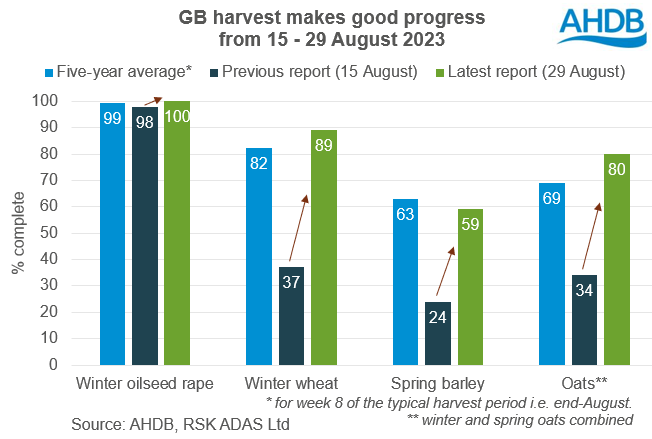GB harvest makes good progress, but variable quality: Grain market daily
Friday, 1 September 2023
Market commentary
- UK feed wheat futures (Nov-23) fell £2.25/t yesterday to £185.85/t as prices for most global grain futures declined.
- Arguably the main reason for lower prices is the weight of Russian supplies on the market. IKAR increased its crop forecast for Russia’s wheat crop from 89.5 Mt to 91.0 Mt and added 2.0 Mt to its export forecast. Also, the Presidents of Russia and Turkey are said to be due to meet to discuss re-starting talks about re-opening a Black Sea shipping channel for Ukrainian grain (Refinitiv).
- There’s less than ideal weather for the major southern hemisphere wheat and barley exporters. The Buenos Aries Grain Exchange reports that low rainfall levels are impacting Argentina’s 2023/24 wheat crop. Meanwhile, Australia recorded its warmest winter on record, with variable rainfall. The Australian government is due to release its next crop forecasts on Tuesday.
- Updated French quality data showed a smaller proportion (91%) achieving the required protein level for milling than in the initial release (93%). However, the proportion is still above the five-year average of 87%; final results are due on 13 September (FranceAgriMer).
- Paris rapeseed futures (Nov-23) gained €3.75/t yesterday to close at to €468.75/t.
GB harvest makes good progress, but variable quality
Drier weather over the past two weeks allowed the GB harvest to make good progress, says the latest AHDB harvest progress report. However, the report also shows variable quality, including some lower Hagberg Falling Numbers (HFN) for winter wheat and germination levels for spring barley.
Good harvest progress
By 29 August, the winter barley harvest was complete, as was the oilseed rape harvest with the exception of a few fields in the North East.
Winter wheat harvesting is now in the latter stages, at 89% complete by 29 August. This is a marked rise from the 37% complete a fortnight earlier and is now ahead of the five-year average for the end of August.
Harvesting of spring barley also made good progress since the last report, though it remains slightly behind the five-year average. The areas with most crops proportionally still to be cut are the North East and Scotland.
Oat harvest progress is now also ahead of the five-year average for the time of year, with the main areas remaining in Yorkshire & The Humber (43% complete) and the East Midlands (60% complete).
Quality indicators variable
We have more information on cereal quality compared to the previous report; this shows the impact of the difficult weather during harvest, with some lower HFN and germination rates. It’s important to note that there are often delays between crops being harvested and quality information becoming available so these figures may still change. However, if confirmed it could point to GB milling wheat and malting barley supplies being tighter this season.
In winter wheat, protein levels so far look encouraging, but there is variation in specific weights and HFN. Typical HFN are ranging between 220–250 nationally, down from 260–300 in the last report.
Barley specific weights are variable, while germination of both winter and spring malting varieties is reported to typically be around 96–98% to date. However, for spring barley, the situation for germination varies amongst the regions for which we have insights. There are better levels in the East and East Midlands, but reports of crops failing germination tests in the West Midlands and Yorkshire. Most spring crops so far have acceptable nitrogen contents and there have not been any reports of any mycotoxin issues.
Oat specific weights are generally said to be acceptable, albeit with some variability. Spring oats are tending to have lower specific weights compared to winter oats.
Yields close to average for most crops
Most crops yields are generally in the region of the previous five-year average; the exception is winter oilseed rape. This had lower yields due to inclement weather during the growing season as well as significant pest damage in some regions, particularly from Cabbage Steam Flea Beetle.
For all crops, higher yields have generally been achieved on heavier land compared to crops on lighter soils that experienced water stress. The sowing date is an important variable for spring barley and oats, with variety also a factor for spring barley.
Sign up
You can subscribe to regular updates straight to your inbox. Create a free account on our Preference Centre and select the information you wish to receive.
While AHDB seeks to ensure that the information contained on this webpage is accurate at the time of publication, no warranty is given in respect of the information and data provided. You are responsible for how you use the information. To the maximum extent permitted by law, AHDB accepts no liability for loss, damage or injury howsoever caused or suffered (including that caused by negligence) directly or indirectly in relation to the information or data provided in this publication.
All intellectual property rights in the information and data on this webpage belong to or are licensed by AHDB. You are authorised to use such information for your internal business purposes only and you must not provide this information to any other third parties, including further publication of the information, or for commercial gain in any way whatsoever without the prior written permission of AHDB for each third party disclosure, publication or commercial arrangement. For more information, please see our Terms of Use and Privacy Notice or contact the Director of Corporate Affairs at info@ahdb.org.uk © Agriculture and Horticulture Development Board. All rights reserved.



